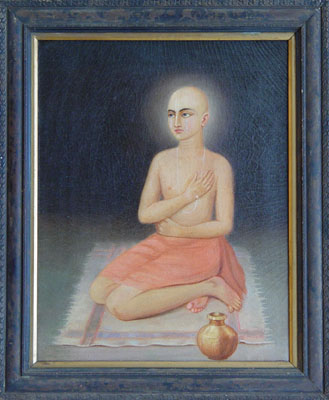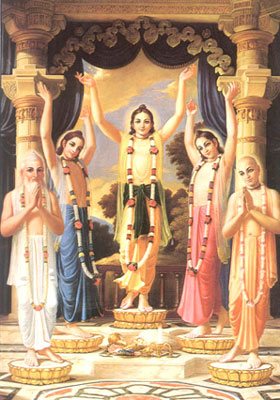
Sri
Gauranga
Ashram
Home
The legacy of Sri Chaitanya
Om Vishnupad 108 Tridandi Swami Sri Srimat Bhakti Sravan Tirtha Goswami Maharaj ki Jai !!
 March 19th 2011 Phalgun Purnima marks the 705th birth anniversary of Shri Krishna Chaitanya Mahaprabhu, the most recent incarnation of Shri Krishna, the Supreme Personality of Godhead.
March 19th 2011 Phalgun Purnima marks the 705th birth anniversary of Shri Krishna Chaitanya Mahaprabhu, the most recent incarnation of Shri Krishna, the Supreme Personality of Godhead.
Phalgun purnima or Gaur Purnima is also the appearance day of Baba, our beloved Gurudev whom we - his devotees - accept to be non- different from Mahaprabhu.
Sri Chaitanya’s lasting contribution to humanity was His distribution of Krishna-prema, or love for God by chanting His holy names, as the best and easiest spiritual practice to attain liberation in this age of Kali.
Sri Chaitanya gave a new impetus to the Bhakti movement in the eastern part of the country, which was then heavily under the influence of Shakta worship – the worship of Goddess Kali and related rituals - as well as Buddhist and Islamic influences. People who took to the renounced order or Sanyas, were mostly in the Shaiva or Shakta line.
Until then, Bhakti was not so closely associated with Sanyas. The famous Bhaktas of the 14th and 15th centuries – votaries of devotion – Vallabha, Nanak, Tulsi, Kabir, Surdas, Meera and Tukaram, were householders from amongst the lower working classes, and even included women. While they were much loved and admired and had developed a following in their regions, the Bhaktas lacked the so-called ‘sanction’ of religious authority.
They could not modify or lay down new social norms for the changing times, nor summon the authority to challenge established convention at a time when Mughal domination and Islam were on the rise and the masses of people were in the grip of blind ritualism and superstition.
The need of the hour was an Avatar – the descent of divinity – to again churn the Vedic teachings of ancient India and cast it in a new mould for the upcoming new era – the arrival of the British and industrial machine age.
Sri Chaitanya is accepted as that Avatar by all major spiritual schools of thought who see a clear pattern of divine intercession in the land of Bharatvarsha whenever its ancient wisdom and spiritual heritage is in danger.
Sri Chaitanya was born in Bengal about 1486 in a well-to-do family of Sanskrit scholars. He was himself a brilliant scholar and teacher of grammar and Sanskrit, whose school or ‘tol’ was much sought after by the gentry for their children.
Chaitanya began travelling around East Bengal and witnessed first-hand the contradictions and injustices of the caste system and the skewed religious dogmas that people were burdened with.
To an intelligent and highly emotional mind such as his, it must have seemed incongruous – to see the mismatch between what he knew existed in the Vedas and Scriptures in terms of liberating knowledge and wisdom and what was being practiced by a majority of people.
Returning to his native Nadia, soon he started a localised preaching and chanting regimen, in the houses of his close associates and neighbours. They would speak and discuss the scriptures, Bhagavat Gita and Bhagavatam and chant and sing the holy name. As this progressed, the gatherings became larger and more vibrant and soon could no longer be contained with the courtyard of a house.
His first serious confrontation with authority was in the form of Chand Kazi, the Badshah’s governor in the province of Nadia, who took up some envious and biased brahmins’ complaints about loud chanting and dancing led by the charismatic Chaitanya. Chand Kazi ordered a complete halt to the unorthodox congregational chanting and dancing, which even the pundits objected to.
It was a turning point in the life of Chaitanya. He responded a day later by calling upon all the residents of Nadia and gathering a huge procession of thousands. They all marched chanting Harinam and bearing torches in the gathering dusk, right to the doorstep of Chand Kazi. The result was unanticipated – Chand Kazi turned into a believer after exchanging a few words with Sri Chaitanya. This was to be one of the many miraculous transformations wrought by Sri Chaitanya in his journey to establish an alternative devotional movement.
Before long, as Chaitanya’s thoughts developed and he assessed and evaluated his own situation and the general environment, he came to the inevitable conclusion that he had something new to offer in terms of a distinctive theology and practice and that unless he did this from a strategic position of authority, it would never be accepted by the religious establishment.
He knew he must renounce family life. As a householder, only his immediate family and community would support and follow him, but as a Sanyasi, he had the opportunity to set an example and push the boundaries of conventional religion.
And so it was that one wintry morning on Magh Purnima, Chaitanya left home – his aged mother and young wife – and embraced Sanyas.
Despite having been initiated in the Madhvacharya tradition, Sri Chaitanya founded a distinctive tradition of his own, having some marked differences with the practices and the theology of the followers of Madhvacharya.
 Sri Chaitanya moved to Jagannath Puri and began to live and preach what came to be known as Gaudiya Vaishnavism – essentially loving devotion and service to Sri Krishna and His various forms, alongwith the divine feminine principle, Sri Radha or Lakshmi.
Sri Chaitanya moved to Jagannath Puri and began to live and preach what came to be known as Gaudiya Vaishnavism – essentially loving devotion and service to Sri Krishna and His various forms, alongwith the divine feminine principle, Sri Radha or Lakshmi.
It was at once a simple and profound concept with hardly any ritualism. Make God the centre of your daily life – live with Him as a family member. Awake, work, eat and sleep with Krishna. And congregational chanting of the sacred Mahamantra: Hare Krishna Hare Krishna Krishna Krishna Hare Hare, Hare Rama Hare Rama Rama Rama Hare Hare.
He travelled around the country on foot twice and initiated many spiritual aspirants into the path of Bhakti. Bhakti he said is easy. It is natural to love God. All that is needed is to establish a relationship with Him – that of a friend, son, parent, master or beloved.
He selected and empowered a few followers, who later came to be known as the Six Gosvamis of Vrindavan, to systematically present the theology of Bhakti he had taught in their writings.
Sri Chaitanya rejected the caste system and his prominent followers included lower castes and muslims as well. Similarly, artisans, craftsmen, painters, and performing artists all benefited from the cultural legacy of Sri Chaitanya by incorporating facets of his life into their art. Baul singers or wandering bards in Bengal are a living example of his cultural legacy even today.
The rendition of the Hare Krishna mahamantra in classical raga is yet another gift of the Chaitanya movement. The mahamantra in selected ragas is believed to awaken the kundalini.
Contemporaneous to the development of modernist humanity in medieval Europe, Sri Chaitanya stated:
bharata-bhumite haila manusya janma yarae
janma sarthaka kari' kara para-upakara
"One who has taken his birth as a human being in the land of India (Bharata-varsa) should make his life successful by striving for the benefit of all humanity." (Cc Adi 9.41)
It wouldn’t be an exaggeration to say that it is directly due to the mission of Sri Chaitanya Mahaprabhu that the Hindu-Vedic culture and traditions are practiced in many parts of the world today.
Jai Sri Radhey !
Jai Gurudeva!